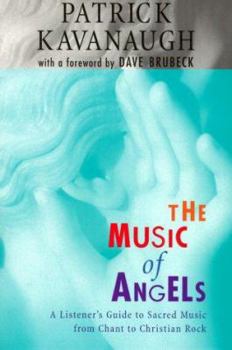The Music of Angels: A Listener's Guide to Sacred Music from Chant to Christian Rock
No Synopsis Available.
Format:Paperback
Language:English
ISBN:0829410198
ISBN13:9780829410198
Release Date:January 1999
Publisher:Loyola Press
Length:332 Pages
Weight:1.10 lbs.
Dimensions:0.7" x 6.0" x 9.0"
Customer Reviews
2 ratings
So close and yet so far
Published by Thriftbooks.com User , 19 years ago
As the excellent review by Messick indicates, this volume is an introduction to the history of sacred music in Western Christianity. This history is painted in broad strokes using representative figures to represent the various eras of musical style. Kavanaugh provides recommendations for listening - recommendations that are accessible to the interested reader. One needs neither theological or musical background to appreciate the book or the recommended music. Even recognizing the need to be selective, however, I have one objection to the book's selectivity. By failing to discuss the popular religious music of the medieval and renaissance periods - for example the pilgrimage songs - the book implies a shift in sacred music with the rise of Protestant hymnody and the gospel song without recognizing its antecedents. With this reservation, I recommend this volume as a solid introduction to sacred music.
A solid introduction and survey
Published by Thriftbooks.com User , 19 years ago
Patrick Kavanaugh's book 'The Music of Angels' is a good survey and overview of the music of the Christian tradition from the earliest days to the present. The book is organised according to three broad sections: Hebrew Psalms to the Renaissance (roughly the first 1500 years, coinciding with the beginning-to-Reformation pattern often followed in history); Baroque to Hymnology (Reformation to the nineteenth century); and Twentieth Century. In the earliest category, development of music derived from the Hebrew synagogue influences of worship music to monophonic chant of different styles, and finally into medieval polyphony and the Renaissance. Much of the music of this period is simple but subtle and beautiful; this is not an era of congregational singing, although monastic communities might incorporate the entire community as singers. Medieval polyphony and the Renaissance periods are when we start knowing composers' names; styles began to differentiate according to national and denominational lines in the late period, with masters of vocal polyphony (Palestrina, Tallis, etc.) and composers who began to be known beyond sacred composition (Gabrieli). The Baroque period is arguably the pinnacle of achievement in Christian sacred music thus far, but it is also the period during which composers began to experiment more widely and become better known for secular compositions. Names such as Monteverdi, Vivaldi, Handel and J.S. Bach come from this time, and new forms of music setting (the oratorio, cantata, passion, etc.) came of age. Following the Baroque period were Classical and Romantic periods - while the composers in these periods did sacred composition, most are known for their secular works primarily if not exclusively in the popular mind (Mozart, Beethoven, Mendelssohn, etc.). Christian music in worship settings was beginning to take on a more participatory role, and the era of hymn singing and composition took hold, particularly in America. Standard settings of hymns according to familiar patterns (harmonisation according to SATB patterns, for example) and the ready availability of printed hymns made congregational singing the primary musical expression in most worship settings. There were still solos and choir pieces, but by and large, the congregation expected (and was expected) to sing. Hymn writers could sometimes be massively prolific, as in the case of the likes of Charles Wesley and Fanny Crosby, who each produced thousands of hymns. The twentieth century saw music shifts influenced significantly by technological change. The availability of instruments as well as the on-demand availability of music of all styles thanks to recording technology made music explode in style and diversity. Christian music still had to battle the kinds of prejudices among the faithful that it often had to fight all along - these things are 'popular' and therefore not 'Christian' or 'spiritual'. Kavanaugh explores all of these issues, wi






